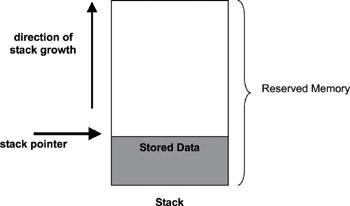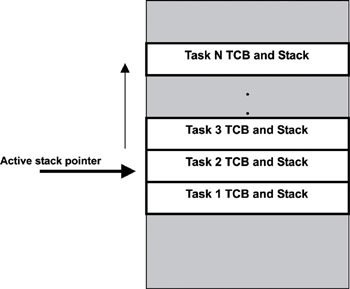10.5.2 Saving Processor States
When an exception or interrupt comes into context and before invoking the service routine, the processor must perform a set of operations to ensure a proper return of program execution after the service routine is complete. Just as tasks save information in task control blocks, exception and interrupt service routines also need to store blocks of information, called processor state information, somewhere in memory. The processor typically saves a minimum amount of its state information, including the status register (SR) that contains the current processor execution status bits and the program counter (PC) that contains the returning address, which is the instruction to resume execution after the exception. The ESR or the ISR, however, must do more to preserve more complete state information in order to properly resume the program execution that the exception preempted. A later section discusses this issue in more detail.
So, whose stack is used during the exception and interrupt processing?
Stacks are used for the storage requirement of saving processor state information. In an embedded operating system environment, a stack is a statically reserved block of memory and an active dynamic pointer called a stack pointer, as shown in Figure 10.3. In some embedded architectures, such as Motorola's 68000 microprocessors, two separate stacks-the user stack (USP) and the supervisor stack (SSP)-are used. The USP is used when the processor executes in non-privileged mode. The SSP is used when the processor executes in privileged mode.

Figure 10.3: Store processor state information onto stack.
Section 10.3.1, 'Internal Errors and Special Conditions Management' on page 145, discusses processor execution modes. On this type of architecture, the processor consciously selects SSP to store its state information during general exception handling. While some architectures offer special support for stack switching, the balance of this chapter assumes a simple environment with just one run-time stack.
As data is saved on the stack, the stack pointer is incremented to reflect the number of bytes copied onto the stack. This process is often called pushing values on the stack. When values are copied off the stack, the stack pointer is decremented by the equivalent number of bytes copied from the stack. This process is called popping values off the stack. The stack pointer always points to the first valid location in order to store data onto the stack. For purposes of this book, the stack grows up; however, a stack can grow in the opposite direction. Note that a typical stack does not store identifiers for the contents. Stack users are required to push and pop items onto and off the stack in a symmetric order. If this rule is not followed during exception or interrupt processing, unintended results are likely to occur.
As Chapter 5 discusses, in an embedded operating system environment, all task objects have a task control block (TCB). During task creation, a block of memory is reserved as a stack for task use, as shown in Figure 10.4. High-level programming languages, such as C and C++, typically use the stack space as the primary vehicle to pass variables between functions and objects of the language.

Figure 10.4: Task TCB and stack.
The active stack pointer (SP) is reinitialized to that of the active task each time a task context switch occurs. The underlying real-time kernel performs this work. As mentioned earlier, the processor uses whichever stack the SP points to for storing its minimum state information before invoking the exception handler.
Although not all embedded architectures implement exception or interrupt processing in the same way, the general idea of sizing and reserving exception stack space is the same. In many cases, when general exceptions occur and a task is running, the task's stack is used to handle the exception or interrupt. If a lower priority ESR or ISR is running at the time of exception or interrupt, whichever stack the ESR or ISR is using is also the stack used to handle the new exception or interrupt. This default approach on stack usage can be problematic with nested exceptions or interrupts, which are discussed in detail shortly.
